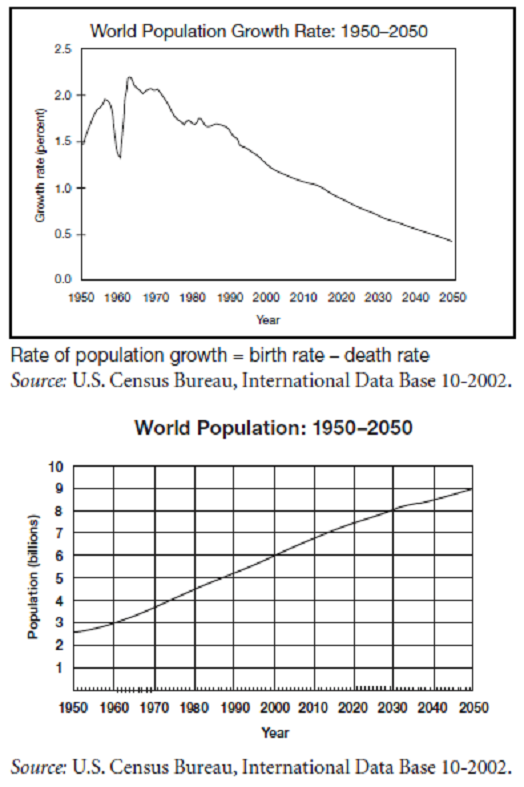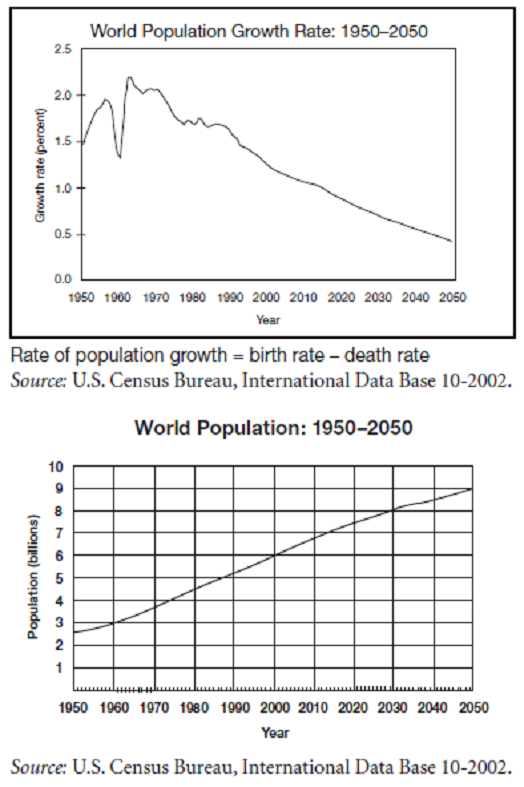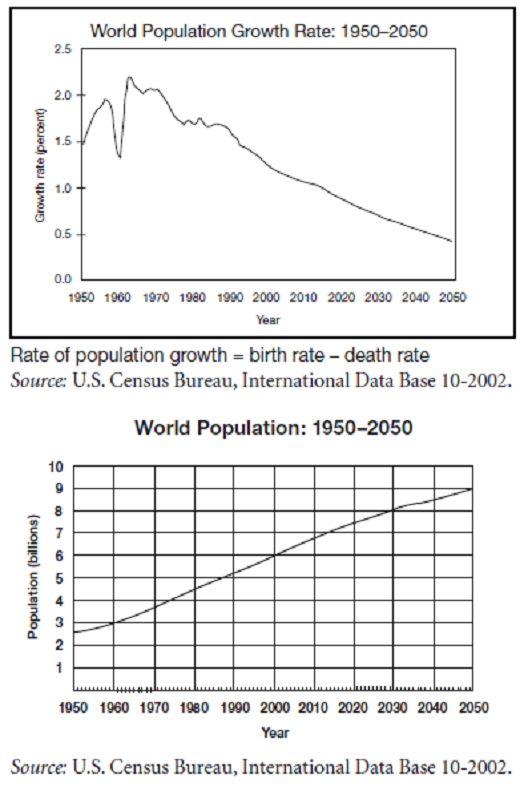Test Prep GED Section 1 Social Studies Exam Practice Questions (P. 2)
- Full Access (65 questions)
- Six months of Premium Access
- Access to one million comments
- Seamless ChatGPT Integration
- Ability to download PDF files
- Anki Flashcard files for revision
- No Captcha & No AdSense
- Advanced Exam Configuration
Question #6
The greatest increase in population growth rate between 1950 and 2000 occurred in


- A1956–1957.
- B1962–1963.
- C1990–2000.
- D2000–2001.
- E2001–2002.
Correct Answer:
B
The first graph shows the highest point in population growth rate between 1962 and 1963.
B
The first graph shows the highest point in population growth rate between 1962 and 1963.
send
light_mode
delete
Question #7
The world population growth rate dropped one percentage point between the mid-1950s and 1960.Which of the following best explains this occurrence?


- AThere were more births and fewer deaths in the mid-1950s than there were in 1960.
- BA baby boom in the decade after World War II caused a spike in the birth rate.
- CThe introduction of the birth control pill in 1960 in the United States helped slow the birth rate.
- DThere were more births in 1960 than there were in the mid-1950s.
- EThere were more deaths in 1960 than there were in the mid-1950s.
Correct Answer:
A
The population growth rate increases when the number of births is larger than the number of deaths.
A
The population growth rate increases when the number of births is larger than the number of deaths.
send
light_mode
delete
Question #8
Which of the following statements is proved by the information in the two graphs?


- AThe population will reach its limit by 2050.
- BWhen the rate of population growth decreases, so does the population.
- CWhen the rate of population growth increases, so does the population.
- DThe rate of population growth will reach an all-time low in 2050.
- EEven though the rate of population growth is decreasing, the population is increasing.
Correct Answer:
E
Using the two graphs, you can compare the rate of population growth with the growth of the population. The growth rate is decreasing, while the population is increasing. None of the other statements is supported by the graphs.
E
Using the two graphs, you can compare the rate of population growth with the growth of the population. The growth rate is decreasing, while the population is increasing. None of the other statements is supported by the graphs.
send
light_mode
delete
Question #9
Even though acid rain looks, feels, and even tastes like clean rainwater, it contains high levels of pollutants. Scientists believe car exhaust and smoke from factories and power plants are the main causes of acid rain, but natural sources like gases from forest fires and volcanoes may also contribute to the problem.
Pollutants mix in the atmosphere to form fine particles that can be carried long distances by wind. Eventually, they return to the ground in the form of rain, snow, fog, or other precipitation. Acid rain damages trees and causes the acidification of lakes and streams, contaminating drinking water and damaging aquatic life. It erodes buildings, paint, and monuments. It can also affect human health. Although acid rain does not directly harm people, high levels of the fine particles in acid rain are linked to increased risk for asthma and bronchitis. Since the 1950s, the increase of acid rain has become a problem in the northeastern United States,
Canada, and western Europe.
Which of the following natural resources is least likely to be affected by acid rain?
Pollutants mix in the atmosphere to form fine particles that can be carried long distances by wind. Eventually, they return to the ground in the form of rain, snow, fog, or other precipitation. Acid rain damages trees and causes the acidification of lakes and streams, contaminating drinking water and damaging aquatic life. It erodes buildings, paint, and monuments. It can also affect human health. Although acid rain does not directly harm people, high levels of the fine particles in acid rain are linked to increased risk for asthma and bronchitis. Since the 1950s, the increase of acid rain has become a problem in the northeastern United States,
Canada, and western Europe.
Which of the following natural resources is least likely to be affected by acid rain?
send
light_mode
delete
Question #10
Even though acid rain looks, feels, and even tastes like clean rainwater, it contains high levels of pollutants. Scientists believe car exhaust and smoke from factories and power plants are the main causes of acid rain, but natural sources like gases from forest fires and volcanoes may also contribute to the problem.
Pollutants mix in the atmosphere to form fine particles that can be carried long distances by wind. Eventually, they return to the ground in the form of rain, snow, fog, or other precipitation. Acid rain damages trees and causes the acidification of lakes and streams, contaminating drinking water and damaging aquatic life. It erodes buildings, paint, and monuments. It can also affect human health. Although acid rain does not directly harm people, high levels of the fine particles in acid rain are linked to increased risk for asthma and bronchitis. Since the 1950s, the increase of acid rain has become a problem in the northeastern United States,
Canada, and western Europe.
Which of the following is NOT a cause of acid rain?
Pollutants mix in the atmosphere to form fine particles that can be carried long distances by wind. Eventually, they return to the ground in the form of rain, snow, fog, or other precipitation. Acid rain damages trees and causes the acidification of lakes and streams, contaminating drinking water and damaging aquatic life. It erodes buildings, paint, and monuments. It can also affect human health. Although acid rain does not directly harm people, high levels of the fine particles in acid rain are linked to increased risk for asthma and bronchitis. Since the 1950s, the increase of acid rain has become a problem in the northeastern United States,
Canada, and western Europe.
Which of the following is NOT a cause of acid rain?
- Ahuman activity
- Bnatural phenomena
- Cvolcanoes
- Dlakes and streams
- Etraffic
Correct Answer:
D
Lakes and streams are affected by acid rain, but do not cause it.
D
Lakes and streams are affected by acid rain, but do not cause it.
send
light_mode
delete
All Pages
